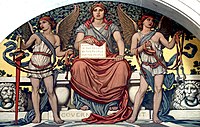
Photo from wikipedia
Abstract Government spending policy has an important macroeconomic stabilization role. We empirically revisit the computation of fiscal cyclicality measures by employing a novel time-varying approach while explicitly dealing with endogeneity… Click to show full abstract
Abstract Government spending policy has an important macroeconomic stabilization role. We empirically revisit the computation of fiscal cyclicality measures by employing a novel time-varying approach while explicitly dealing with endogeneity concerns. Analyzing a sample of 36 advanced economies from 1970 to 2015, the focus of the paper is on the spending side of the budget and its components. The average government spending cyclicality is −0.9, pointing to sample counter-cyclicality. However, there is considerable cross-country heterogeneity: in less than 50 percent of the sample, cyclicality coefficients are negative and statistically significant. We also uncover that government spending has become increasingly more countercyclical between 1970 and mid-1990s. Several factors drive the degree of spending cyclicality. More developed economies (more open to trade) tend to have a smaller (higher) degree of spending procyclicality. Countries with larger governments and those with better institutions are able to provide more fiscal stabilization.
Journal Title: Economic Modelling
Year Published: 2020
Link to full text (if available)
Share on Social Media: Sign Up to like & get
recommendations!